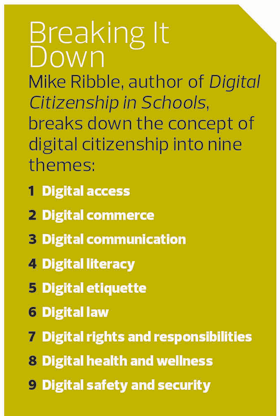Meet the New School of Digital Citizenship
Driving home from school, a teacher with the Lewisville Independent School District overheard her high school–aged son tell a friend about something he posted online. When she asked what he wrote, he explained that he carefully chose his words because he didn't want to disappoint his principal.
That's a good digital citizen, explains Jody Rentfro, emerging technologies specialist at Lewisville ISD in Texas. The student stopped to consider who would see his post and how readers would react to it. "I think there are kids in college who aren't aware of that," she adds.
A quick scan through social media sites shows that even many adults don't consider the consequences of their actions online. Thoughtless comments, compromising photos and oversharing are rampant on the web, and more people are paying attention, including college admissions officers, employers and criminals.
As the stakes of online content grow, schools around the globe have built increasingly comprehensive digital citizenship programs aimed at helping students — and teachers, staff and parents — to stay safe, be wise consumers, respect intellectual property, communicate effectively and think critically on the Internet.
"It's really a moral imperative that we have these conversations with our students," says Barbara Brown, chief technology officer at Lewisville ISD. "They need to realize that their digital footprints will follow them their entire lives."
Learning to use technology appropriately and responsibly has become even more crucial with the growth of mobile devices, one-to-one technology programs and social media. "We have so much access to technology all the time," says Mike Ribble, director of technology at the Manhattan-Ogden Unified School District No. 383 in Kansas and author of Digital Citizenship in Schools. "I'm talking about 7- and 8-year-olds who are inundated with this."
Venturing Out
What does it mean to be a good digital citizen? Is it a matter of being considerate? Safe? Respectable?
Ribble likens digital citizenship to being part of a physical community. Teachers establish lessons and rules to help students learn what it means to be responsible members of a classroom community, a school, a neighborhood and so on.
What Ribble struggles with is how to gradually build communities on the Internet.
"If an 8-year-old joins Facebook, he's suddenly exposed to all these people — some are friends, some are family, some are strangers," he explains. "How do we help him navigate that?"

Ribble divides digital citizenship into nine themes, which fall into three categories: respect, educate and protect, or REPs. If teachers focus on one theme within each category per year, students receive increasingly higher-level REPs rather than being overwhelmed with too much material at once.
For instance, the first REP he recommends, for kindergarten through second grade, is digital etiquette, communication and rights and responsibilities. The second, taught in grades three through five, includes digital access, literacy and safety/security.
In the third REP, sixth- to eighth-grade students are ready to learn about legal issues such as piracy and plagiarism, as well as secure commerce and health and wellness — reinforcing the idea of staying fit rather than always using technology.
Launching a digital citizenship initiative doesn't have to be complicated, says Kelly Mendoza, a senior professional development manager at Common Sense Education and one of the creators of its K–12 Digital Literacy & Citizenship Curriculum.
Schools can start small — post an article or show a video that's available for free from organizations like Common Sense Education, BrainPOP and Carnegie Mellon University, Mendoza recommends. "It may seem overwhelming," she says. "But just make the priority this year of building a culture in your school."
Lewisville ISD's digital citizenship program uses a variety of resources, including free curricula from Common Sense Education and NetSmartz Workshop, a program of the National Center for Missing & Exploited Children.
Rentfro suggests beginning with a simple exercise: Have students Google their names to see what comes up. Then ask them what they'd like people to see when they search for them. "Teach students to create their own personal brand," she says.
Building a Program
The roots of many digital citizenship programs are in the acceptable-use policies that districts created when they began giving students access to the Internet.
"Our initial Internet safety concern was cyberpredators," says Gail Desler, technology integration specialist at California's Elk Grove Unified School District. "We soon realized that beyond keeping students safe from others, we needed to help keep them safe from each other and from themselves."
Elk Grove USD's early focus on Internet safety has evolved to include four areas: cyberbullying, building positive digital footprints, protecting online privacy and respecting intellectual property. Each school develops an annual implementation plan for teaching digital citizenship. At the close of the school year, principals must sign a document verifying that their schools taught digital citizenship.
Desler and her digital citizenship co-coordinator Kathleen Watt facilitate workshops for teachers and administrators to share ideas and collaborate on initiatives.
The district has supported and promoted a number of student-led digital citizenship campaigns such as the #unfollowbullying campaign. "When students step up and speak out against bullying, it's very powerful," Desler says.
Digital citizenship at Lewisville ISD began as a school-level program, but has expanded into a district initiative. And it's not just for students. Campus principals and central office leadership recently attended a workshop on digital citizenship, and the district is working with parent groups to disseminate digital citizenship resources to parents.
"We believe that digital citizenship has to be a part of the culture and climate in your school district," says Brown. "Everyone needs to model what it means to be a good digital citizen."








